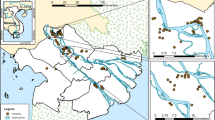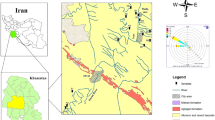Abstract
Modern agricultural systems have to provide enough micronutrient output to meet all the nutritional needs of people. Accordingly, knowledge on micronutrient status in soil and crop edible tissues is necessary. This study was carried out to investigate zinc (Zn), iron (Fe), manganese (Mn), and copper (Cu) concentration of calcareous paddy soil and the relative rice grain. Rice crops (straw, hull, and grain) and associated surface soils (0–25 cm) were collected from 136 fields and analyzed for total and diethylene triamine pentaacetic acid (DTPA) available Zn, Fe, Mn, and Cu. The DTPA-Zn concentration in more than 50% of paddy soils was less than its critical deficiency concentration (2 mg kg−1), while the concentrations of DTPA Fe, Mn, and Cu were sufficient. The grain Zn concentration of more than 54% of the rice samples was less than 20 mg kg−1. About 55% and 49% of the rice samples were deficient in Mn and Cu, respectively, while the Fe concentration in rice grains was sufficient. A significant negative correlation was found between the CaCO3 content and soil DTPA-extractable Zn, Fe, Mn, and Cu. There were significant relationships between the total soil phosphorus and DTPA-extractable micronutrient concentrations. By considering the average daily rice consumption of 110 g per capita, the Zn, Fe, Mn, and Cu intake from rice consumption was estimated to be 2.4, 7.7, 1.6, and 0.7 mg for adults, respectively.
Similar content being viewed by others
References
Alloway BJ (2006) Zinc in soils and crop nutrition. Online book published by the International Zinc Association, Brussels, Belgium. Available via http://www.zinc-crops.org/
Bernstein L (1969) Salt tolerance of plants. U.S. Dep. Agric. Information Bull
Black CA, Evans DD, White JL, Ensminger LE, Clark FE (1965) Methods of soil analysis. Part 2. Agron Monogr. 9. ASA. Madison. WI, pp 1387–1388
Bonsmann SSg, Hurrell R (2009) The impact of trace elements from plants on human nutrition: a case for biofortification. In: Banuelos GS, Lin Z-Q (eds) Development and uses of biofortified agricultural products. CRC, Boca Raton, pp 1–6
Bremner JM (1996) Nitrogen—total. In: Sparks DL (ed) Methods of soil analysis Part 3: Chemical methods. SSSA Book Series, vol. 5, SSSA and ASA, Madison, WI, pp 1085–1121
Brummer GW, Gerth J, Tiller KG (1988) Reaction kinetics of the adsorption and desorption of nickel, zinc, and cadmium by goethite. I. Adsorption and diffusion of metals. J Soil Sci 39:37–52
Cakmak I, Yilmaz A, Kalayci M, Ekiz H, Torun B, Erenoglu B, Broun HJ (1996) Zinc deficiency as a critical problem in wheat production in Central Anatolia. Plant Soil 180:165–172
Chapman HD, Pratt PF (1961) Methods of analysis for soils, plants and waters. Univ. of Calif. Div. of Agric. Sci. Riverside, CA
Chumbley CG, Unwin RJ (1982) Cadmium and lead content of vegetable crops grown on land with a history of sewage sludge application. Environ Pollut B Chem Phys 4:231–237
Cui YL, Zhu YG, Zhai RH, Chen DY, Yz H, Qui Y (2004) Transfer of metals from soil to vegetable in an area near a smelter in Nanning, China. Environ Int 30:785–791
Deng CB, Tang XL, Zhang XH (1989) The structure and resources of food and the assumption of the future in Liaoning province. Liaoning Agric Sci 1:1–8
Doberman A, Fairhurst T (2000) Rice nutrient disorders and nutrient management. International Rice Research Institute, Manila
Dudka S, Piotrowska MP, Matysiak Z, Witek T (1995) Spatial distribution of trace metal concentrations in arable soils and plants of Poland. Pol J Environ Stud 4:9–16
Freytag J (1986) Bestimmung von Transferfaktoren Boden/Pflanze einiger Elemente und Untersuchungen über deren Abhängigkeit von ausgewählten Bodeneigenschatten. Hambg Bodenkdl Arb 1:43–51
Frossard E, Bucher M, Machler F, Mozafar A, Hurrell R (2000) Potential for increasing the content and bioavailability Fe, Zn and Ca in plants for human nutrient. J Sci Food Agric 80:861–879
Graham RD, Welch RM, Bouis HE (2001) Addressing micronutrient malnutrition through enhancing nutritional quality of staple foods: principles, perspectives and knowledge gaps. Adv Agron 70:77–142
Harrison RM, Chirgawi MB (1989) The assessment of air and soil as contributes of some trace metals to vegetable plants III experiment with field-grown plants. Sci Total Environ 83:47–63
Lindsay WI, Norvell WA (1978) Development of a DTPA soil test for zinc, iron, manganese, and copper. Soil Sci Soc Am J 42:421–428
Lubben S (1993) Abhängigkeit der Schwermetall-Transferfaktoren Boden/Pflanze vom Kontaminationsgrad des Bodens VDLUFA-Schriftenreihe, Kongressband, pp 605–608
Institute of Medicine, Food and Nutrition Board (2001) Dietary reference intakes for Vitamin A, Vitamin K, Arsenic, Boron, Chromium, Copper, Iodine, Iron, Manganese, Molybdenum, Nickel, Silicon, Vanadium and Zinc. Standing Committee on the Scientific Evaluation of Dietary Reference Intakes. Food and Nutrition Board, Institute of Medicine. National Academy Press, Washington
Mortvedt JJ (1996) Heavy metal contamination in inorganic and organic fertilizers. Fert Res 43:55–61
Nelson DW, Sommers LE (1982) Total carbon, organic carbon, and organic matter. In: Page AL, Miller RH, Keeney DR (eds) Methods of soil analysis. Part 2, 2nd ed. Agron. Monogr. 9. ASA and SSSA, Madison, WI, pp 539–579
Olsen SR, Sommers LE (1982) Phosphorus. In: Page AL, Miller RH, Keeney DR (eds), Methods of soil analysis. Part 2, 2nd ed. Agron. Monogr. 9, ASA, Madison, pp 403–431
Prasad AS (2001) Discovery of human zinc deficiency: impact on human health. Nutrition 17:685–687
Raskin I, Ensley BD (2000) Phytoremediation of toxic metals: using plants to clean up the environment. Wiley, New York
Rice Research Institute of Iran (RRII) (2008) Available at http://berenj.areo.ir/
Schulin R, Khoshgoftarmanesh AH, Afyuni M, Nowak B, Frossard E (2009) Effect of soil management on zinc uptake and its bioavailability in plants. In: Banuelos GS, Lin Z-Q (eds) Development and uses of biofortified agricultural products. CRC, Boca Raton, pp 95–114
Subramanian KC, Bharathi C, Jegan A (2008) Response of maize to mycorrhizal colonization at varying levels of zinc and phosphorus. Biol Fertil Soils 45:133–144
Wang Q, Yan B, Zhang S (2005a) Distribution characteristics of mercury in the region contaminated by zinc smelting and chlor-alkali production. In: Trindade RBE, Melamed R, Sobral LGL et al (eds) XIII International Conference on Heavy Metals in the Environment. CETEM/MCT, Rio de Janeiro
Wang X, Sato T, Xing B, Tao S (2005b) Health risk of heavy metals on the general public in Tianjin, China via consumption of vegetable and fish. Sci Total Environ 350:28–37
Welch RM (2002) The impact of mineral nutrients in food crops on global human health. Plant Soil 247:83–90
Welch RM, Graham RD (2002) Breeding crops for enhanced micronutrient content. Plant Soil 245:205–214
Wilde SA, Corey RB, Iyer JG (1979) Soils and plant analysis for tree culture. Part 3. Analysis of plant tissue. Oxford and IBH, New Delhi, pp 93–106
World Health Organization (WHO) (1989) Evaluation of certain food additives and contaminants, 33rd Report of the Joint FAO/WHO Expert Committee on Food Additives, Technical Report Series 776. WHO, Geneva
World Health Organization (WHO) (2004) Available at http://www.who.int/en/
Zhang F, Fan M, Gao X, Zou C, Zuo Y (2009) Soil and crop management for improving iron and zinc nutrition of crops. In: Banuelos GS, Lin Z-Q (eds) Development and uses of biofortified agricultural products. CRC, Boca Raton, pp 71–94
Zheng N, Qichao W, Dongmei Z (2007) Health risk of Hg, Pb, Cd, Zn and Cu to the inhabitants around Huludao Zinc Plant in China via consumption of vegetables. Sci Total Environ 383:81–89
Author information
Authors and Affiliations
Corresponding author
Rights and permissions
About this article
Cite this article
Pirzadeh, M., Afyuni, M., Khoshgoftarmanesh, A. et al. Micronutrient status of calcareous paddy soils and rice products: implication for human health. Biol Fertil Soils 46, 317–322 (2010). https://doi.org/10.1007/s00374-009-0428-1
Received:
Revised:
Accepted:
Published:
Issue Date:
DOI: https://doi.org/10.1007/s00374-009-0428-1




